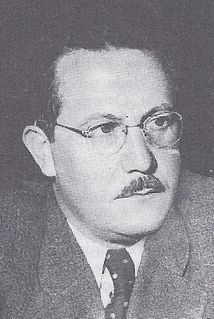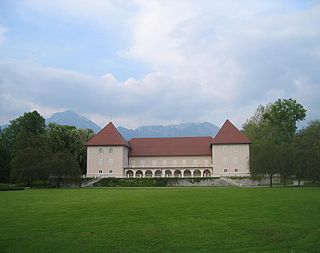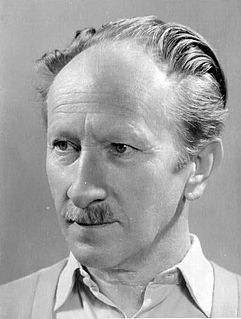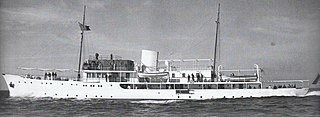
Josip Broz, commonly known as Tito, was a Yugoslav communist revolutionary and statesman, serving in various roles from 1943 until his death in 1980. During World War II, he was the leader of the Yugoslav Partisans, often regarded as the most effective resistance movement in German-occupied Europe. He also served as the president of the Socialist Federal Republic of Yugoslavia from 14 January 1953 until his death on 4 May 1980.

Edvard Kardelj, also known by the pseudonyms Bevc, Sperans and Krištof, was a Yugoslav politician and economist. He was one of the leading members of the Communist Party of Slovenia before World War II. During the war, Kardelj was one of the leaders of the Liberation Front of the Slovenian People and a Slovene Partisan, and after the war, he was a federal political leader in the Socialist Federal Republic of Yugoslavia and led the Yugoslav delegation in peace talks with Italy over the border dispute in the Julian March. He was the main creator of the Yugoslav system of workers' self-management. He was an economist and a full member of both the Slovene Academy of Sciences and Arts and the Serbian Academy of Sciences and Arts. he played a major role and setting the foreign policy by designing the fundamental ideological basis for the Yugoslav policy of nonalignment in the 1950s and the 1960s.

Velenje is Slovenia's sixth-largest city, and the seat of the Municipality of Velenje. The city is located in northeastern Slovenia, among the rolling green hills of the Šalek Valley, with the Kamnik–Savinja Alps to the west and the Pohorje Mountains to the east.

Brdo Castle near Kranj, usually simply Brdo Castle, is an estate and a mansion in the Slovenian region of Upper Carniola west of the village of Predoslje, City Municipality of Kranj, northwest of Ljubljana. It is the Slovenian government's main venue for diplomatic meetings and other Government-sponsored events.

The prime minister of Yugoslavia was the head of government of the Yugoslav state, from the creation of the Kingdom of Serbs, Croats and Slovenes in 1918 until the breakup of the Socialist Federal Republic of Yugoslavia in 1992.

Rear-Admiral Sir Morgan Charles Morgan-Giles, was a Royal Navy officer, decorated during the Second World War, who later served as a Conservative Member of Parliament. At the time of his death, he was the oldest living former member of the House of Commons.

The Beograd class of destroyers consisted of three ships built for the Royal Yugoslav Navy in the late 1930s, to a French design. Beograd was constructed in France and Zagreb and Ljubljana were built in the Kingdom of Yugoslavia. During the German-led Axis invasion of Yugoslavia in April 1941, Zagreb was scuttled to prevent its capture, and the other two were captured by the Italians. The Royal Italian Navy operated the two captured ships as convoy escorts between Italy, the Aegean Sea, and North Africa. One was lost in the Gulf of Tunis in April 1943; the other was seized by the Germans in September 1943 after the Italian surrender and was subsequently operated by the German Navy. There are conflicting reports about the fate of the last ship, but it was lost in the final weeks of the war.

Edvard Kocbek was a Slovenian poet, writer, essayist, translator, member of Christian Socialists in the Liberation Front of the Slovene Nation and Slovene Partisans. He is considered one of the best authors who have written in Slovene, and one of the best Slovene poets after Prešeren. His political role during and after World War II made him one of the most controversial figures in Slovenia in the 20th century.

Kamniška Bistrica is a small dispersed settlement close to the source of the Kamnik Bistrica River in the Municipality of Kamnik in the Upper Carniola region of Slovenia.

Josip Kopinič was a Slovenian communist and close associate of Josip Broz Tito.

Ernest Peterlin was a Slovene military officer who rose to a senior position in the Royal Yugoslav Army prior to the Second World War. Married to Anja Roman Rezelj. A decided anti-Communist, during the war he became a prominent anti-Partisan military leader and one of the main exponents of the pro-Western faction of the Slovene Home Guard, an anti-Communist collaborationist militia active in parts of German-occupied Slovenia between 1943 and 1945. In 1945, he was tried and sentenced to death by the new Yugoslav Communist authorities and executed in 1946.

Izidor Cankar was a Slovenian author, art historian, diplomat, journalist, translator, and liberal conservative politician. He was one of the most important Slovenian art historians of the first part of the 20th century, and one of the most influential cultural figures in interwar Slovenia.

The Adriatic campaign of World War II was a minor naval campaign fought during World War II between the Greek, Yugoslavian and Italian navies, the Kriegsmarine, and the Mediterranean squadrons of the United Kingdom, France, and the Yugoslav Partisan naval forces. Considered a somewhat insignificant part of the naval warfare in World War II, it nonetheless saw interesting developments, given the specificity of the Dalmatian coastline.
Boris Furlan was a Slovenian jurist, philosopher of law, translator and liberal politician. During World War II, he worked as a speaker on Radio London, and was known as "London's Slovene voice". He served as a Minister in the Tito–Šubašić coalition government. In 1947, he was convicted by the Yugoslav Communist authorities at the Nagode Trial.

Herta Haas was a Slovene and Yugoslav Partisan during World War II and the second wife of Josip Broz Tito, leader of the Partisans and a future President of Yugoslavia.

Vladimir Popović Lukin, also known as Vlado Popović, was a Yugoslav diplomat, communist politician and army general. He was a close associate of Josip Broz Tito. He was, during his career, a delegate to the UN, close associate of Josip Broz Tito, Yugoslavia's envoy (ambassador) to the USSR, US, China, and Vietnam, member of the federal government of Yugoslavia, and chair of the Committee for Foreign Affairs of the Federal Assembly of Yugoslavia, and secretary to the presidency until his death in 1972.

The Orjen class of eight motor torpedo boats was built for the Royal Yugoslav Navy between 1936 and 1939 at the Lürssen Shipyard at Vegesack, Germany. They were based on the German S-2 motor torpedo boats. At the start of the Axis invasion of Yugoslavia, two boats managed to escape to Alexandria in Egypt where they continued serving with Allied forces, including in operations against Vichy French forces in Syria. The remaining ones were captured by Italian forces and commissioned in the Regia Marina with modified armament; they were also used by the Italians as the model for the Italian-built CRDA 60 t motor torpedo boats.

Beli Orao was a royal yacht built in 1938–39 for the Yugoslav Royal Navy, which intended her to serve as a patrol boat, escort, or guard ship in wartime. Upon completion, she was pressed into service as the admiralty yacht – used by senior admirals for transport and to review fleet exercises. She was captured in April 1941 by the Italians during the World War II Axis invasion of Yugoslavia. The Regia Marina replaced her guns and used her as a gunboat for harbour protection and coastal escort duties, briefly as Alba then Zagabria. She was then used to train anti-submarine warfare specialists from the naval base at La Spezia.

Romania–Yugoslavia relations were historical foreign relations between Romania and now broken up Yugoslavia. Relations between Romania and independent South Slavic states developed before creation of Yugoslavia and union of Transylvania with Romania and those relations played prominent role during the Second Balkan War. Relations between the two states were generally friendly and were only occasionally affected by wider alliance policies.


















